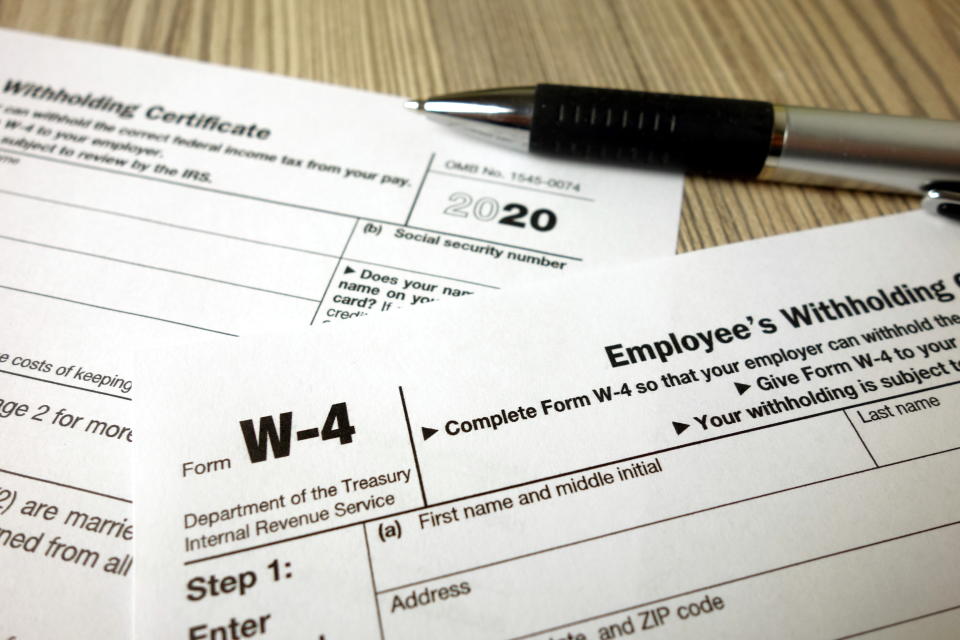4 reasons you should change your tax withholdings
Even though this year’s tax season is over, that doesn’t mean your tax business is done.
You may want to revisit the tax withholdings from your paycheck, pension check, or unemployment benefits check. The wrong amount of withholdings could mean a smaller tax refund next year — or even worse, a big tax bill.
There are several reasons why you may need to change your tax withholdings. Here’s what to know.
Major change to your life
Did you get married or divorced? Did you have or adopt a child? Did your income (or your spouse’s) income dramatically change? These are all good reasons to review your paycheck withholdings to make sure enough is being paid to the government.
Big life changes like those mentioned above affect your tax filing status and any tax credits or deductions you’ll be eligible for. They also can alter your tax liability. That’s why it’s important to make sure your withholdings are up to date and reflect your current personal situation.

Bad tax outcome this year
If your refund was smaller than expected — or worse, you owed the government money — it’s time to revisit your paycheck withholdings.
If you want a larger refund next year, you need to adjust your withholdings so that more tax is taken out of each of your bi-weekly or monthly paychecks. Your refund is equal to how much you overpay the government in tax during the year.
If you want to avoid owing the government next year, then it’s important to increase your tax withholdings in each paycheck as well, so that you don’t underpay during the year.
Need more cash flow
If your income is lower than it used to be — perhaps from the economic fallout from the coronavirus pandemic — changing your withholdings could be one way to increase your monthly cash flow.
You can opt to send less tax per paycheck to the federal government and pocket it yourself, helping you with bills and other financial obligations. The downside is that you will get a smaller or none at all next year at tax time. Don’t reduce your withholdings too much, though, or you could end up owing the tax man next year.

You’re getting unemployment benefits
If you lost your job and are now receiving unemployment benefits, make sure your taxes are withheld from each check.
Unemployment insurance is a joint state-federal program and those who get it must pay federal and state taxes on it because those benefits are considered income by the Internal Revenue Service (IRS). The federal tax rate is 10%, but the state rate varies from 4% to 10% depending on where you live.
If you live in Alaska, Florida, Nevada, South Dakota, Texas, Washington, or Wyoming, you will only have to pay federal tax because those states have no personal income tax. In California, New Jersey, Oregon, Pennsylvania, and Virginia, there is a tax exemption for unemployment benefits.
How to change your withholdings

To figure out your withholdings, use the IRS’s Tax Withholding Estimator, which can be adjusted to meet your personal circumstances. The tool allows you to choose what refund amount you want to receive next year — if any — and will calculate how much to withhold to achieve that goal.
To get the most reliable withholdings estimate, you’ll need your most recent pay statements for yourself and your spouse, if applicable; any information for other sources of income you have; and your most recent income tax return. Use the results to change your paycheck withholdings.
On your employer paycheck: Complete a new Form W-4, Employee's Withholding Certificate, which you can get from your employer’s payroll department. Submit the form to your employer as soon as possible. Many companies have an automated system for submitting withholdings changes. Check with your payroll department to see if this option is available.
If you receive pension income: Complete a Form W-4P and give it to your pension or annuity payer.
On your unemployment check: When you first apply for unemployment benefits, you should have the option to elect automatic withholding. If you failed to do this, you can file a W-4V, or Voluntary Withholding Request, to have state and federal taxes automatically withheld from your unemployment payment.
Janna is an editor for Yahoo Money and Cashay, a new personal finance website. Follow her on Twitter @JannaHerron.
Read more information and tips in our Taxes section
Read more personal finance information, news, and tips on Cashay






